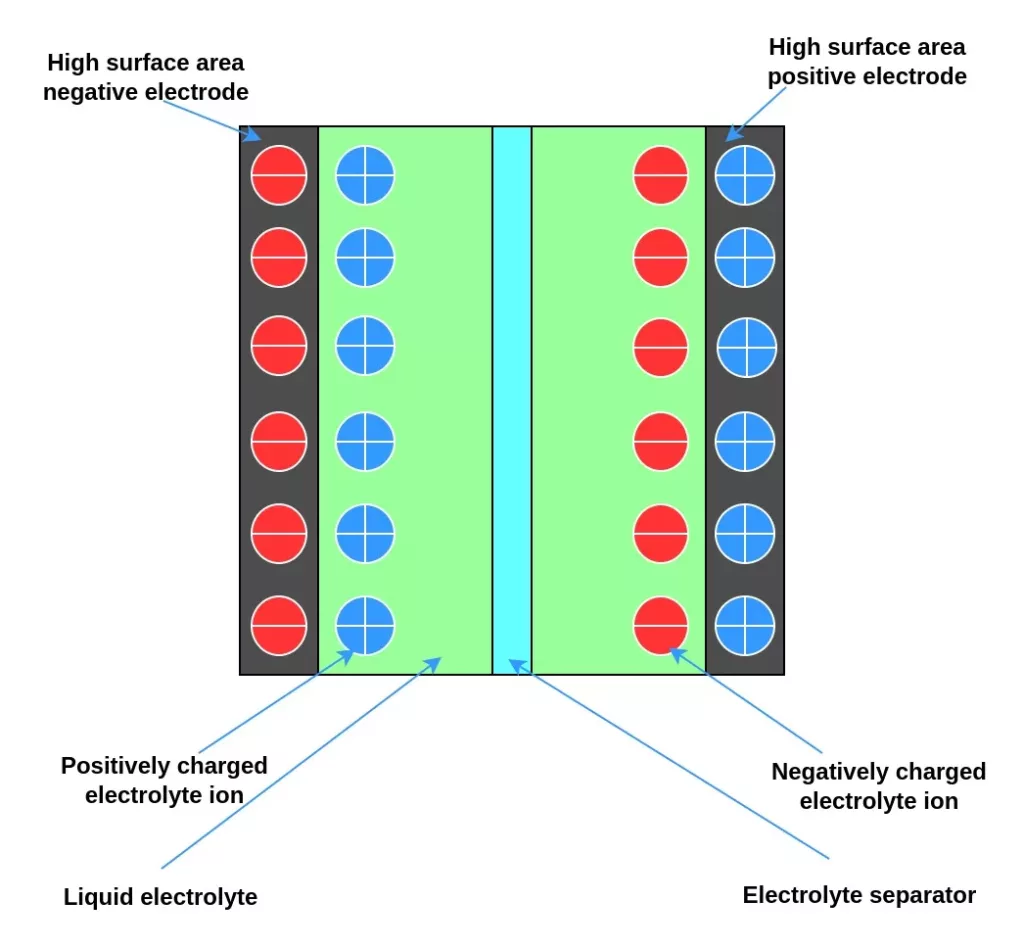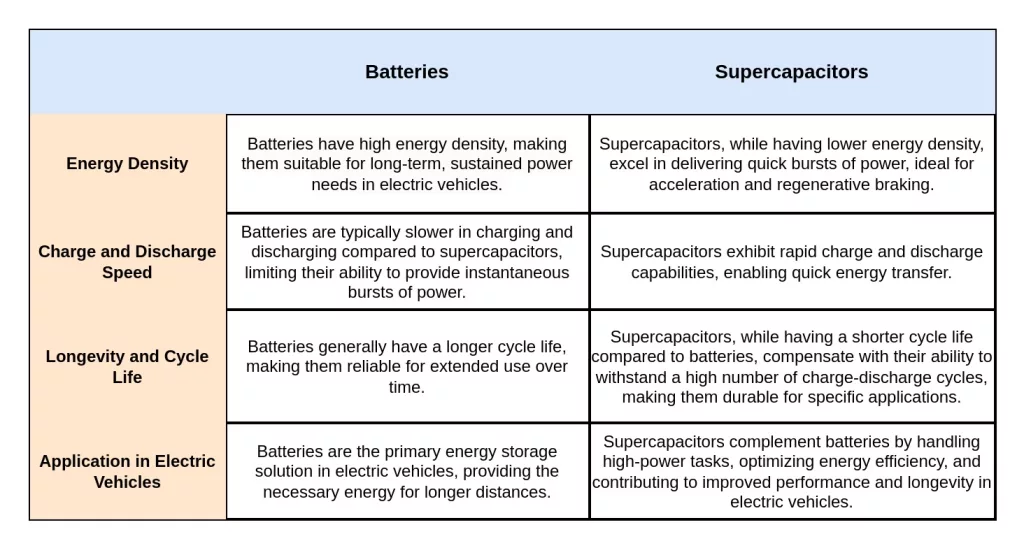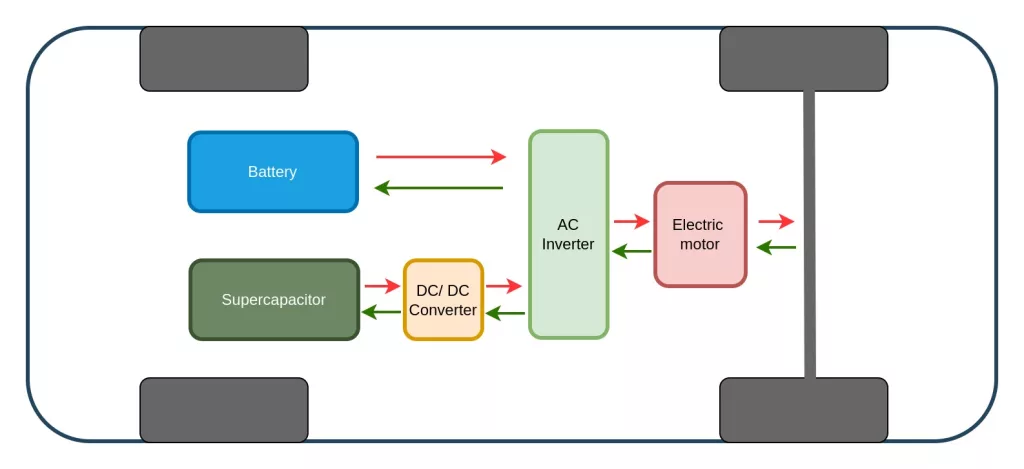Supercapacitors are revolutionizing the electric vehicle landscape, offering a swift and efficient energy storage solution. Unlike traditional batteries, supercapacitors boast rapid charging capabilities, a key factor in reducing electric vehicle charging times. With their ability to store and deliver energy quickly, ultracapacitors enhance the overall performance of electric vehicles, providing a greener and more sustainable mode of transportation.
As the automotive industry accelerates towards eco-friendly solutions, supercapacitors are emerging as a pivotal technology, promising a future where EVs are not only environmentally conscious but also faster and more accessible for all. This article delves into diverse applications of supercapacitors in electric vehicles. To learn more about the construction and types of supercapacitors, see our introductory guide to supercapacitors.
Principle of operation of a supercapacitor
What is a supercapacitor? Supercapacitors are also known as ultracapacitors or electric double-layer capacitors (EDLCs). They are energy storage devices that operate on a fundamentally different principle than traditional batteries. Unlike batteries, which rely on chemical reactions to store and release energy, EDLCs store energy electrostatically. Their core components include two electrodes and an electrolyte solution, with a separator in between (see Figure 1). When a voltage is applied, ions in the electrolyte accumulate on the surface of the electrodes, forming an electric double layer. This electrostatic storage allows supercapacitors to rapidly charge and discharge energy.

One key feature of ultracapacitors is their high power density, enabling them to deliver bursts of energy quickly. This is particularly advantageous in applications requiring rapid energy transfer, such as electric vehicles. While batteries provide sustained power over longer periods, supercapacitors complement them by offering quick bursts of energy during acceleration or regenerative braking. This dual system optimizes efficiency and enhances the overall performance of electric vehicles.
Supercapacitors play a crucial role in addressing the limitations of batteries. Their ability to charge rapidly, withstand numerous charge-discharge cycles, and operate effectively in a wide temperature range makes them ideal for various applications. These applications range from consumer electronics to renewable energy systems and electric vehicles. As technology advances, researchers continue to explore ways to improve supercapacitor energy density and further integrate them into diverse fields, contributing to a more sustainable and energy-efficient future.
Supercapacitors available in the market come in different shapes and sizes, from small ones like surface-mounted and coin-type to larger ones like radial lead-type, laminate-type, and big screw terminal type. They vary in capacity too, ranging from compact ones with less than 1F to large ones exceeding 2000F. These diverse options cater to a wide range of electronic needs and industries.
Characteristics of supercapacitors
The superiority of supercapacitors in powering the electric vehicle revolution lies in their distinctive characteristics. From rapid charging and high power density to extended cycle life and resilience across diverse temperatures, each feature contributes to their unmatched efficiency in meeting the dynamic energy demands of electric transportation. Below are the key characteristics of supercapacitors:
- Rapid charging and discharging: supercapacitors excel in swift charge and discharge cycles. This facilitates quick energy transfer essential for acceleration and regenerative braking in electric vehicles.
- High power density: their high power density allows ultracapacitors to deliver bursts of power efficiently. This helps to complement the sustained power delivery of batteries in electric vehicles.
- Long cycle life: while having a shorter overall lifespan than batteries, supercapacitors can endure a high number of charge-discharge cycles. This makes them durable and suitable for a broad array of applications in electric vehicles.
- Temperature resilience: ultracapacitors operate effectively across a wide temperature range. This ensures reliable performance in various environmental conditions, a critical factor for electric vehicle applications.
- Low maintenance requirements: ultracapacitors have fewer maintenance needs compared to traditional batteries. This contributes to the overall efficiency and cost-effectiveness of electric vehicle systems.
- Regenerative braking optimization: supercapacitors are particularly advantageous in regenerative braking systems. They are capable of capturing and efficiently storing energy during braking events, which can then be rapidly released for acceleration.
- Reduced weight and size: supercapacitors offer a lightweight and compact alternative to traditional energy storage solutions. This contributes to the overall weight reduction and space optimization in electric vehicles.
Supercapacitor vs battery performance in electric vehicles
Electric vehicles employ both batteries and supercapacitors. Batteries pack more energy for longer trips, while supercapacitors bring speed with rapid charge and discharge. A hybrid energy storage system, combining both batteries and supercapacitors, can offer a balanced solution that optimizes the strengths of each technology, leading to more efficient and sustainable electric vehicles. Table 1 compares supercapacitor and battery energy storage systems.

Strengths of supercapacitors in electric vehicle applications
- Rapid charging and discharging: supercapacitors excel in quick charge and discharge cycles. This makes them ideal for electric vehicle applications that require rapid energy transfer, such as regenerative braking and acceleration.
- High power density: with a high power density, ultracapacitors can deliver instantaneous bursts of power. This enhances the overall performance and responsiveness of electric vehicles.
- Extended cycle life: supercapacitors have a longer cycle life compared to traditional batteries, withstanding numerous charge-discharge cycles. This durability is advantageous for electric vehicles, especially in energy recuperation systems.
- Versatility in temperature: effective operation across a wide temperature range allows supercapacitors to maintain performance in various environmental conditions. This characteristic contributes to their reliability in electric vehicles.
Limitations of supercapacitors in electric vehicle applications
- Energy density: supercapacitors have relatively lower energy density compared to batteries. While suitable for quick bursts of energy, they may be less practical for applications requiring sustained energy over longer durations.
- Self-discharge: supercapacitors experience self-discharge over time, which can lead to gradual energy loss. This limitation may impact their effectiveness in electric vehicle applications that require long-term energy storage without frequent recharging.
- Cost: ultracapacitors can be more expensive than traditional batteries. This may impact their widespread adoption in electric vehicles, especially in cost-sensitive markets.
- Limited energy storage duration: due to their lower energy density, ultracapacitors may be less suitable for electric vehicle applications that require extended energy storage without frequent recharging.
Strengths of batteries in electric vehicle applications
- Higher energy density: batteries offer higher energy density compared to ultracapacitors. This allows them to store and provide a significant amount of energy over extended periods. This characteristic is advantageous for electric vehicles requiring consistent and sustained power output.
- Flexibility in chemistries and form factors: batteries are available in a broader range of chemistries and form factors. This offers greater flexibility in design and integration into various devices and systems. This adaptability enhances their applicability in diverse electric vehicle configurations.
- Advancements in technology: ongoing advancements in battery technology have led to improvements in energy density, cycle life, and safety features. These enhancements contribute to the overall efficiency and reliability of batteries in electric vehicles.
Limitations of batteries in electric vehicle applications
- Limited power density: batteries exhibit lower power density compared to ultracapacitors. This makes them less suitable for applications that require rapid bursts of energy, such as instantaneous acceleration in electric vehicles.
- Finite cycle life: batteries have a finite cycle life, degrading over time and usage. The number of charge-discharge cycles they can endure before significant capacity loss varies based on the battery chemistry, posing a consideration for long-term applications.
Applications of supercapacitors in electric vehicles
Supercapacitors are utilized in electric vehicles for a diverse array of applications, ranging from turbocharging acceleration to extending battery life. Figure 2 illustrates the integration of supercapacitor and battery energy storage systems in an electric vehicle. The versatility of these components makes them ideal for a wide range of uses, including the following:

- Regenerative braking: supercapacitors play a pivotal role in regenerative braking systems in electric vehicles. They efficiently capture and store excess energy during braking events. This energy can then be rapidly discharged to assist in acceleration, enhancing overall energy efficiency.
- Quick energy boosts: supercapacitors provide quick bursts of power, making them ideal for applications requiring sudden and high-energy demands in electric vehicles. This is particularly advantageous during acceleration, enabling rapid response and enhanced performance.
- Reducing battery stress: by handling high-power tasks, supercapacitors can alleviate stress on the main battery in electric vehicles. They can deliver instantaneous power during peak demand, reducing the strain on the battery and potentially extending its lifespan.
- Extending battery life: supercapacitors contribute to extending the overall life of electric vehicle batteries. By efficiently managing rapid charge and discharge cycles, they optimize the energy flow within the system. This potentially reduces wear and tear on the primary battery.
- Enhancing energy recovery: supercapacitors enhance energy recovery in electric vehicles by efficiently capturing and storing energy that would otherwise be lost during braking or deceleration. This contributes to improved overall energy efficiency and increased range.
- Hybrid energy storage systems: the integration of supercapacitors in electric vehicles often involves hybrid energy storage systems. These systems combine the strengths of both batteries and supercapacitors. This approach optimizes energy management, offering a balance between sustained power delivery and quick bursts of energy.
- Reducing charging time: supercapacitors can be employed to reduce charging times for electric vehicles. Their rapid charge and discharge capabilities enable quick replenishment of energy, providing a practical solution for drivers with limited charging time.

Pingback: A Guide to Types and Applications of Supercapacitors -